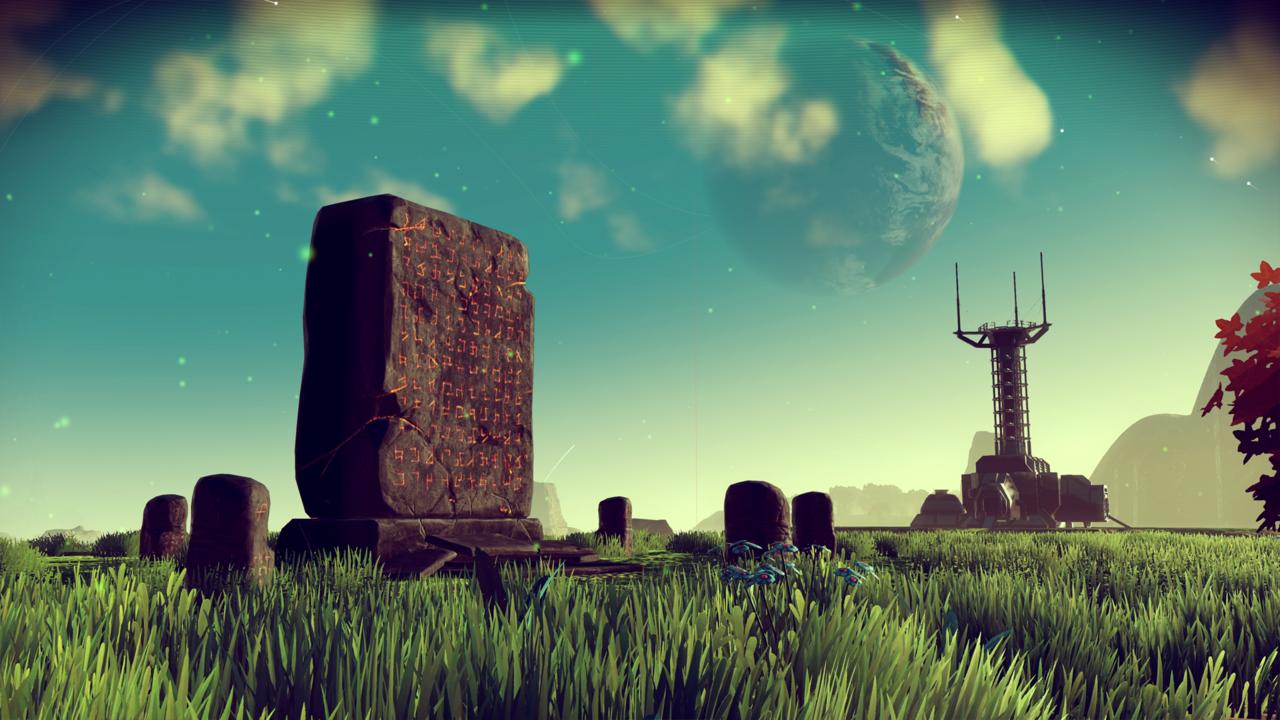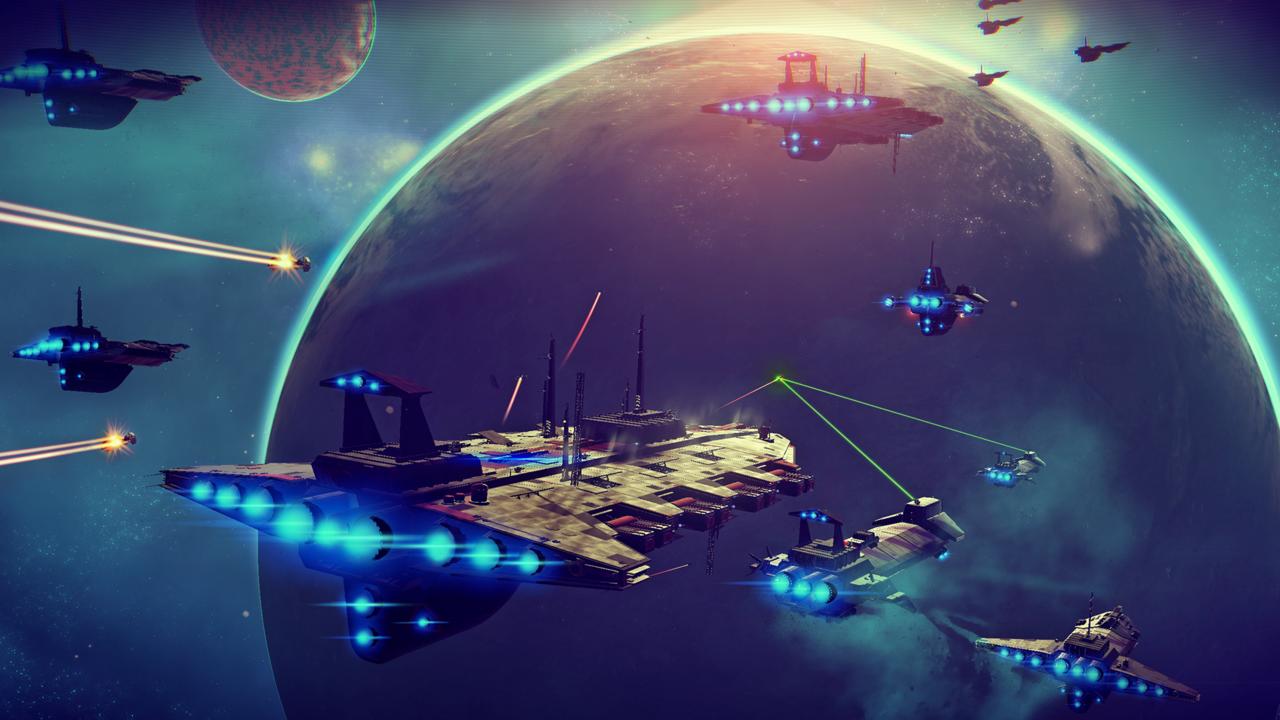If you've been looking forward to the upcoming space exploration game No Man's Sky, chances are that you've heard about its absurdly big procedurally generated universe. But just like when talking about the actual universe, the size of the playable area of No Man's Sky dwarfs our normal conceptions of the world so completely that it's difficult to actually comprehend.
When developer Hello Games talks about the number of planets that you can visit in the game, it's challenging to wrap your head around it. 18,446,744,073,709,551,616 really doesn't mean much when written on a page, even when spelled out as eighteen quintillion planets. It's just an absurdly large number that doesn't have any immediate analogue.
But even though 18,446,744,073,709,551,616 is so huge that it's silly, No Man's Sky's universe still has limits. It's not infinite. You can hit the edge of the game's galaxy, or reach the center. So to make that number--18 quintillion--a little more understandable, and to better contextualize No Man's Sky, let's take a look at how this compares to other video games, the Earth, and our real universe.
These calculations are based on my own speculation and the handful of details that Hello Games has shared. We'll have to wait for the official release in August to confirm that the universe is as unbelievably large as the studio says it is.
Eighteen Quintillion
There've been other big space exploration games before No Man's Sky that claim to have galaxy-sized worlds. To be sure, some of them are massive:
- Stellaris--1000 star systems, with 10-15 planets each
- EVE: Online--8000 solar systems
- Elite: Dangerous--400 billion star systems
- No Man's Sky--18 quintillion planets
Even if you estimate Elite's star systems as containing a handful of planets--let's say 10, for ease of calculations--that would amount to a paltry 4 trillion planets. You'd need 4.5 million copies of Elite's galaxy to equate to No Man's Sky's.
Assassin's Creed Shadows Hands-On Preview DOOM: The Dark Ages | Gameplay Sizzle Trailer NINJA GAIDEN 2 Black Official Launch Trailer NINJA GAIDEN 4 Official Announce Trailer Assassin's Creed Shadows: Story Trailer Assassin's Creed Animus Hub - Explanatory Overview Trailer Black Ops 6 - Season 02 Cinematic Trailer Pokémon TCG Pocket: Space-Time Smackdown | Coming Soon! FINAL FANTASY VII REBIRTH - PC Launch Trailer over the hill - Announcement Trailer PAYDAY 3: Don't Be a Hero Trailer Vampires: Bloodlord Rising | Dragos Gameplay Trailer
Please enter your date of birth to view this video
By clicking 'enter', you agree to GameSpot's
Terms of Use and Privacy Policy
In the real world, you probably hear huge numbers being discussed most frequently in the context of the economy. National economies work with massive amounts of money, and so we are used to hearing about sums in the billions or even trillions. The gross world product--essentially the monetary worth of all the work done per year--is about $107 trillion. If each No Man's Sky planet was worth a dollar, the total value of the game's planets would be 172,000 times the amount that the world produces every year.
It also helps to compare the planets of No Man's Sky to incredibly small things, such as grains of sand or gallons of water--both measured in quadrillions and quintillions. Back in 2012, researchers at the University of Hawaii estimated that there are 7 quintillion 500 quadrillion grains of sand on the Earth's surface. No Man's Sky's planets beat that by about two and a half times.
But No Man's Sky finally meets its match when compared to the gallons of water in the world's oceans. At around 350 quintillion gallons, the volume of water in the oceans exceeds the number of planets in the game.
Here are some other real-world comparisons:
- Books published--130 million
- People on Earth--7.4 billion
- Cells in a human body--37 trillion
- Highest-denomination banknote of Hungarian currency printed--1 sextillion (one thousand quintillion)
- Atoms in a .1 mL drop of water--10 sextillion
- No Man's Sky planets--18 quintillion
Of course, a single instance of each of these is dwarfed by one planet-sized planet in the game. If you start considering the amount of planet surface explorable in No Man's Sky, the numbers get even more ridiculous.
How Many Earths Can You Fit in One Game?
Hello Games has claimed in the past that the planets you'll visit will be actually planet-sized--meaning that it'll take you hours or days to circumnavigate. However, the studio's been unclear on exactly how big the planets are, so I'll use the very conservative estimate based on pre-release demos in my attempt to contextualize the size of the game.

As helpfully explained by Reddit user Rossmancer, the E3 2015 demo of the game can be used to calculate the diameter of the planet visited. Since this is an E3 demo, the planet is heavily modified. This also means that it would be quite a bit bigger in the final release. With that being said, Rossmancer figured out that the diameter of the planet would be about 5 miles across.
Knowing this, we can find the total surface area of one of these planets. Using the demo planet's radius of 2.5 miles, its surface area would be 78.5 square miles. This is minuscule compared to the Earth, which has a surface area of 197 million square miles. But it makes more sense when compared to other games:
- Fallout 4--43 square miles
- Grand Theft Auto V--49 square miles
- Just Cause 3--400 square miles
- One planet in No Man's Sky--78.5 square miles
It's also comparable to a small city, like Boston, which has a land area of 90 square miles.
But, once again, there's that eighteen quintillion number. If you take just one planet in No Man's Sky, it's easy to contextualize. But take the whole game, and the explorable surface area becomes nonsensical, even when using the conservative estimate of planet size. If we assume that every planet is the same size, then the game would have over 1 sextillion (that's a 1 with 21 zeroes) square miles of planet surface area. Now we're getting to even more absurdly large numbers. So let's try to make this a little bit more comprehensible.
Considering that the Earth's surface is 200 million square miles, No Man's Sky has the equivalent of 7 trillion Earth surfaces. If you added up the surface area of every planet and the Sun in our Solar System, you'd need 400 billion Solar Systems to match No Man's Sky.
In other words, this is truly a galaxy. Recently, NASA's Kepler Observatory has discovered dozens of exoplanets (planets outside our solar system). As a result of these findings, scientists have estimated the number of terrestrial (read: not gas giants with solid surfaces you can stand on) planets in our galaxy at 40 billion. No Man's Sky's total number of planets obviously exceeds this, but it does give a bit of helpful context for understanding its scope.
The Creatures You'll Discover
This game would be pretty boring if all those 18 quintillion planets were uninhabited and uninteresting, but luckily Hello Games is designing them to be both diverse in landscape and in life. Don't expect to find life on every planet, or even most of them, though: Hello Games has confirmed that there'll be simple life (plants, maybe small animals) on about 10 percent of the planets. Complex life will show up less frequently, on about 1 percent of the planets. But very complex life--civilizations, perhaps--will only appear on roughly 1 in 100 million planets.
Assassin's Creed Shadows Hands-On Preview DOOM: The Dark Ages | Gameplay Sizzle Trailer NINJA GAIDEN 2 Black Official Launch Trailer NINJA GAIDEN 4 Official Announce Trailer Assassin's Creed Shadows: Story Trailer Assassin's Creed Animus Hub - Explanatory Overview Trailer Black Ops 6 - Season 02 Cinematic Trailer Pokémon TCG Pocket: Space-Time Smackdown | Coming Soon! FINAL FANTASY VII REBIRTH - PC Launch Trailer over the hill - Announcement Trailer PAYDAY 3: Don't Be a Hero Trailer Vampires: Bloodlord Rising | Dragos Gameplay Trailer
Please enter your date of birth to view this video
By clicking 'enter', you agree to GameSpot's
Terms of Use and Privacy Policy
Even this extremely rare chance of finding incredibly complex life, though, means that there is still a massive amount of those kinds of lifeforms out there in the galaxy. 100 million sounds big, but it's really tiny relative to the entire game: if that probability is accurate, then there's roughly 180 billion planets out there with complex life. Unfortunately, chances are high that you'll never find one of these planets. 1 in 100 million is like winning the lottery. To provide a very morbid comparison, you're about ten times more likely to die in a plane crash than find a species of super interesting creatures on any one planet you visit.
Speaking of extremely unlikely possibilities...
Finding Other People
No Man's Sky has a shared universe, and Hello Games has said that it has a matchmaking style similar to Journey's. You can stumble across someone else working their way through the galaxy, or happen upon a planet already discovered by another explorer. But Hello Games makes it clear that you almost certainly will not find another person during the entire time you play the game. It's not even entirely clear how multiplayer will work at all, or even if there'll be multiplayer in the traditional sense.
But since this is a shared universe, there's a chance that two people might be on the same planet at the same time, even if they don't see each other. This can be estimated using the same formula as the birthday problem. If we assume that 1 million people will be playing the game at the same time--which would be a pretty impressive number of concurrent players--and all of them are on some planet, then the chance that at least two of them are on the same planet is extremely small: .00000271%. For there to be a 1% chance that at any moment two or more people are on the same planet, about 600 million people would have to be playing simultaneously.

The goal of the game is to get to the center of the universe, so as everyone journeys closer to the middle, the chances of meeting someone else will undoubtedly go up. This is probably your best bet for running into another player: a more limited space, with much fewer planets, means that it's likely that you'll see another explorer out there--or at least, you'll see the planets they've already discovered. In the Milky Way, for instance, scientists have tracked a group of 28 stars closest to the galaxy's center, which allowed them to discover signs of the supermassive black hole holding the galaxy together. If No Man's Sky follows this model, then it's a good bet that you'll see signs of other players when you finally reach the middle.
The insane number of planets is only one element of the game, and it's unclear yet how No Man's Sky will tie it all together into a cohesive, engaging experience. It will have several other mechanics besides exploration to keep players interested, such as crafting, trading, combat, and deciphering alien languages. But ultimately we'll have to wait for its release on August 9 for PS4 and PC to determine whether or not we'll want to explore more than just a handful of planets in No Man's Sky's massive galaxy.

